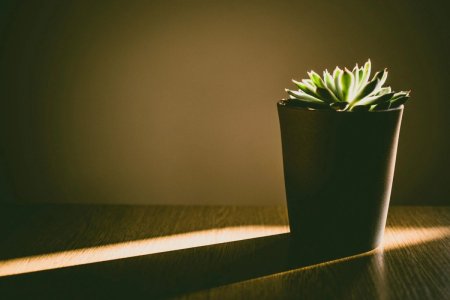These signs will tell you if your plants are begging for more sunlight!
By
Veronica E.
- Replies 0
There’s something special about the calm and comfort houseplants bring into our homes.
They clean our air, add a fresh touch of nature to our spaces, and quietly lift our moods.
But thriving houseplants need more than just water and attention—they rely heavily on getting the right amount of sunlight, too.
If you’ve ever wondered whether your green companions are getting all the sunshine they need, you’re not alone.
Understanding their needs is the first step to helping them not just survive—but truly flourish.

Before you start shifting your plants around the house, it’s important to know that not all plants crave the same amount of light.
Different species have different needs, and knowing which group your plant belongs to can make all the difference in its health and happiness.
1. Low-light plants: The shade lovers
Low-light plants are perfectly content in indirect or filtered light.
These hardy plants are ideal for areas that don’t get strong sunlight all day long, thriving quietly away from the brightest spots.
Think of them as the introverts of the plant world—calm, adaptable, and happy in gentle, subdued light.
2. Medium-light plants: The moderates
Plants that prefer medium light enjoy a little sun but not too much.
They thrive near east- or west-facing windows where they can bask in morning or afternoon light without getting scorched.
They’re like the "Goldilocks" of houseplants—preferring conditions that are not too bright and not too dim.
3. High-light plants: The sun seekers
High-light plants love the spotlight—literally.
They do best when placed in front of a south-facing window where they can soak up several hours of strong, direct sunlight each day.
These bold growers often have vivid colors and grow quickly when their sun cravings are satisfied.
Even with the best care, it’s easy to miss signs that your plants need more light.
Luckily, they have a few ways of letting you know when something isn’t quite right.
Here are the common signals to watch for:
If your plant is showing signs of needing more light, there are simple ways to help:
By tuning into these signs and making a few adjustments, you can create a lush indoor haven where every plant thrives!
Read next: Transform your garden for spring with this $4.99 ALDI gadget—even cheaper than Home Depot!

Have you noticed a difference in your plants after adjusting their sunlight exposure? Do you have a favorite method for making sure your plants get the light they need? We’d love to hear your tips, tricks, and questions!
They clean our air, add a fresh touch of nature to our spaces, and quietly lift our moods.
But thriving houseplants need more than just water and attention—they rely heavily on getting the right amount of sunlight, too.
If you’ve ever wondered whether your green companions are getting all the sunshine they need, you’re not alone.
Understanding their needs is the first step to helping them not just survive—but truly flourish.

Proper sunlight exposure helps houseplants grow strong, healthy, and vibrant indoors. Image Source: Pexels / Lisa from Pexels.
Understanding your plant’s sunlight needs
Before you start shifting your plants around the house, it’s important to know that not all plants crave the same amount of light.
Different species have different needs, and knowing which group your plant belongs to can make all the difference in its health and happiness.
1. Low-light plants: The shade lovers
Low-light plants are perfectly content in indirect or filtered light.
These hardy plants are ideal for areas that don’t get strong sunlight all day long, thriving quietly away from the brightest spots.
Think of them as the introverts of the plant world—calm, adaptable, and happy in gentle, subdued light.
2. Medium-light plants: The moderates
Plants that prefer medium light enjoy a little sun but not too much.
They thrive near east- or west-facing windows where they can bask in morning or afternoon light without getting scorched.
They’re like the "Goldilocks" of houseplants—preferring conditions that are not too bright and not too dim.
Also read: Breathe cleaner air while you sleep with these 6 magical indoor home additions
3. High-light plants: The sun seekers
High-light plants love the spotlight—literally.
They do best when placed in front of a south-facing window where they can soak up several hours of strong, direct sunlight each day.
These bold growers often have vivid colors and grow quickly when their sun cravings are satisfied.
Also read: Beware: The toxic, creepy plant invading US National Parks—Is it watching you?
Decoding the signs of sunlight starvation
Even with the best care, it’s easy to miss signs that your plants need more light.
Luckily, they have a few ways of letting you know when something isn’t quite right.
Here are the common signals to watch for:
- Leaf discoloration: Yellowing leaves often point to a lack of light.
- Leggy growth: Stems that stretch long and thin are reaching for more sunshine.
- Small leaves: If new leaves are tiny, your plant might not be getting the energy it needs.
- Lack of blooms: Flowering plants that fail to produce blossoms may be light-starved.
- Slow growth: Plants that seem stalled in their development could be craving more sunlight.
Also read: Don’t throw out your chocolate boxes—gardeners are loving this surprising trick!
Turning the light on: Easy fixes for sun-hungry plants
If your plant is showing signs of needing more light, there are simple ways to help:
- Play musical chairs: Move plants closer to windows or sunnier spots in your home.
- Rotate regularly: Give your plants a little spin every week so all sides receive even light.
- Supplement with grow lights: Artificial lighting can make a big difference, especially in rooms with limited natural light.
- Prune wisely: Trim leggy stems to encourage healthier, fuller growth.
- Propagate new plants: Use trimmed cuttings to grow new plants that can start life in better conditions.
By tuning into these signs and making a few adjustments, you can create a lush indoor haven where every plant thrives!
Read next: Transform your garden for spring with this $4.99 ALDI gadget—even cheaper than Home Depot!
Key Takeaways
- It's essential to understand the specific light requirements for each houseplant to ensure they thrive indoors.
- Houseplants display clear signs such as leaf discoloration and leggy growth when they are not receiving enough sunlight.
- The placement of houseplants near windows or light sources is crucial to meet their varying needs for low, medium, or high light exposure.
- Adjusting a plant's environment by moving it closer to natural light or using artificial lighting can help remedy insufficient sunlight and promote healthy growth.
Have you noticed a difference in your plants after adjusting their sunlight exposure? Do you have a favorite method for making sure your plants get the light they need? We’d love to hear your tips, tricks, and questions!






